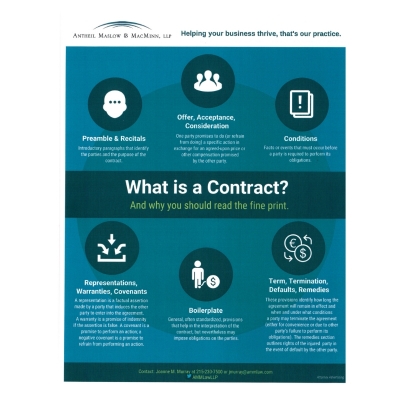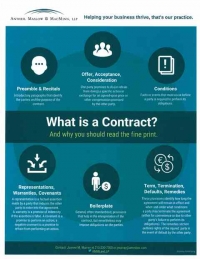What is a contract: Part 2: Offer, Acceptance, Consideration: What’s in it for you?
Written by Joanne MurrayThis post continues my series explaining the main elements of a contract, which are outlined on the attached infographic. My goal is to demystify some of these basic provisions to help business owners have a better general understanding of what they are signing.
Moving through the structure of a typical contract, next up is offer, acceptance, and consideration. Together, these clauses define what the offering party is promising to do (or refrain from doing) in exchange for the compensation the other party is willing to pay or provide. They basically comprise the tit for tat, or the meat of the obligations and privileges which are being offered. This is often referred to as a “meeting of the minds.” While this might seem obvious on its face, the devil may be in these details, so it is vital that you know and understand the specific nature of your obligations and be sure that they are sustainable, practical, and likely to result in a benefit to your bottom line or some other benefit to your business. So what can happen when parties fail to clearly memorialize their “meeting of the minds”? Here are a few scenarios that could result:
• The parties might become embroiled in a “battle of the forms”, particularly in the sale of goods context where a buyer submits a purchase order using their company’s form, and the seller responds using their own terms and conditions form containing different and/or additional terms.
• Parties can ask the court to apply certain legal theories to supplement the “four corners of the document” where the intent of the parties may not be clear from the contract itself. For example, even if there is no formal consideration, courts can apply the theory of promissory estoppel to enforce a party’s promise to do something if the other party relied on that promise to his or her detriment.
• Another equitable remedy allows the court to compel a party to make restitution if that party is enriched at the expense of the other party and the surrounding circumstances lead the court to conclude that it is unjust.
• Pennsylvania has a little-known statute called the Uniform Written Obligations Act, which allows the court to infer that consideration exists where the agreement includes language that clearly and expressly states that the parties intended to be legally bound by the agreement.
Stay tuned for Part 3 of this series, which will move to the next element on the infographic: Conditions.
Visit ammlaw.com to learn more about our contract review services, or Joanne Murray.
NONCOMPETE LITIGATION LESSONS FROM THE TENTH CIRCUIT
Written by Patricia Collins
Reprinted with permission from the August 18th, 2018 issue of The Legal Intelligencer. (c) 2018 ALM Media Properties. Further duplication without permission is prohibited.
A recent case from the United States District Court for the Tenth Circuit, First American Title Insurance Company, et al. v. Northwest Title Insurance Agency, et al., no. 17-4086, illustrates nicely the complicated issues faced in noncompete litigation, and the risks a good agreement can prevent. Although the case arose in the United States District Court for the District of Utah, the issues confronted and legal principles cited arise frequently under Pennsylvania law.
The individual defendants were employed by First American Title Insurance Company, and had signed various restrictive covenants of one year in duration. All individual defendants were subject to a code of ethics and employee handbook that required employees to use office equipment for company business only, and barred outside activity competing with First American. First American Title Company acquired the stock of First American Title Insurance Company pursuant to a Stock Purchase Agreement. Defendant Smith created defendant Northwest Title Insurance Company, and then quit his job with First American. The day after Smith resigned defendants Carrell and Williams resigned and all individual defendants took positions at Northwest Title Insurance Company, along with twenty-five other employees over the next two weeks. Litigation ensued, and defendants suffered a large jury award at trial.
Lesson 1: File petitions for preliminary injunction early, and make sure to have a tolling provision in the agreement.
The First American District Court denied the plaintiff’s motion for a preliminary injunction after a hearing, finding that there was no irreparable harm. Notably, the individual defendants resigned in March of 2015, and their restrictive covenants, which did not contain tolling provisions, terminated in March of 2016. Plaintiffs filed the petition for preliminary injunction in January of 2016, with only two months remaining on the restrictive covenants, and the motion was not heard until September 2016. The case then proceeded to a trial, resulting in the appeal addressed by the Tenth Circuit. An injunctive order entered early in a case tends to change the dynamic of a case going forward, providing opportunities for sanctions and contempt motions, and an incentive to settlement. Certainly, defendants enjoyed an early victory that rendered this case solely about damages. Indeed, this may well have been the strategy: part of the court’s reasoning on the preliminary injunction was that most of the damage had already been done, in light of the quick transfer of customers and employees.
A preliminary injunction is only powerful when filed early, and it might be worth considering foregoing the motion in certain circumstances, where the tactical advantages of early filing are lost. Most importantly, a tolling provision in the document might have changed the outcome: drafters must include a provision that extends the duration of the restrictive covenant where the employee is in breach.
Before Signing That Commercial Lease – Have You Reviewed it with Counsel?
Written by Stephanie M. ShortallAs a business owner, after spending countless hours researching and visiting commercial space, and finally finding the right location, you are often presented with a lengthy commercial lease. Many will focus on the rent and term of the lease, but overlook the other details. It is important to have an attorney review any commercial lease, whether you are entering a new lease or renewing an existing lease. Far too often, the business owner only consults an attorney when a problem arises – and they are surprised to find out that the terms do not mean what they thought at the outset.
Key areas that the business owner should review with their attorney are:
• Common area maintenance costs and calculations
• Confessions of judgment
• Responsibility for repairs
• Insurance requirements
• Subletting and assignment
• Legal options in the case of a breach.
Often there is room for negotiation, but even if there is not, you can gain valuable knowledge by consulting with an attorney so that you have a full understanding of your rights and obligations, and can plan accordingly.
While consulting with an attorney may result in a modest increase to the amount of legal fees associated with the cost of starting up a business, it is important for small business owners to recognize the long term impact of signing a lease that has not been negotiated, or at least reviewed, by an attorney, and may save money in the long run.
Antheil Maslow & MacMinn, LLP, a Bucks County-based full-service law firm, is pleased to announce the addition of Mariam W. Ibrahim to the Firm’s Family Law practice group. Ms. Ibrahim
practices exclusively in the area of family law, handling a variety of issues, including divorce, child support, alimony/spousal support, equitable distribution and child custody matters. Prior to joining the firm, Ms. Ibrahim served as a judicial law clerk to the Honorable Judge Jeffrey G. Trauger in the Bucks County Court of Common Pleas.
Learn more about Mariam Ibrahim.
Probate vs. Nonprobate Property in Your Estate – Your Will is Not the Only Way
Written by Elaine T. YandrisevitsSo you have finally wrapped your head around the fact that you need to create an estate plan in order to determine to whom and in what amounts your property will pass upon your death. Estate planning attorneys realize that it is difficult to think about one’s own mortality, and getting clients to this point is half the battle. What you will want to consider as you go through this process is that your estate planning documents may not control the distribution of your entire estate. The distributions of some types of assets, categorized as nonprobate assets, are controlled by operation of law instead of the estate planning documents. While the creation of wills, trusts, and other estate planning documents is a crucial part of the estate planning process, it is equally important to understand how your nonprobate property will be distributed upon your death and, if necessary, coordinate the passage of the nonprobate property with your estate plan.
For estate planning and estate administration purposes, there are two broad categories of property: probate and nonprobate. Probate property is the property a person owns in his or her individual name that does not include a beneficiary designation. Common examples of probate property include individual bank accounts, vehicles, individually-owned real estate, and tangible personal property. An interest in jointly-owned property that is owned as tenants-in-common is also considered probate property because the individual’s interest in this property is severable from the other joint interests.
In contrast, nonprobate property is made up of two main types. The first type of nonprobate property is the property that a person owns as an individual but for which the person named beneficiaries by completing a beneficiary designation form provided by the financial institution holding the funds. This type of nonprobate property typically includes retirement accounts (401(k)s, 403(b)s, IRAs, etc.), life insurance, and financial accounts with a “payable on death” (POD) or “in trust for” (ITF) designation. The second type of nonprobate property is property that a person owns jointly with other individuals that is designated as being owned as tenants by the entireties (if the co-owners are a married couple) or jointly with the right of survivorship. Jointly-owned property may include real estate or financial accounts; in fact, Pennsylvania law provides that a jointly owned financial account is automatically considered to be owned jointly with the right of survivorship unless there is clear and convincing evidence that the co-owners intended for the account to be owned as tenants-in-common.
Most estates are a combination of probate and nonprobate property; however, recent trends show that nonprobate assets comprise a larger portion of an individual’s estate than in the past. This trend is important to note in an estate planning and estate administration context because nonprobate assets will be distributed by operation of law to the named beneficiaries under the beneficiary designations or the surviving joint owner, not to the beneficiaries named under the decedent’s estate planning documents. For this reason, it is important not only to know which assets are nonprobate at the time the estate plan is created, but also to update beneficiary designations (or even reconsider the titling of joint assets) after the estate planning documents are executed. Updating beneficiary designations is particularly important for older nonprobate assets, such as a 401(k) from a first job, that have beneficiary designations that were completed many years ago and may no longer reflect your life circumstances, let alone your estate plan.
A few examples illustrate these points. As a first example, suppose that a husband and wife execute Wills that leave all assets to the surviving spouse upon the first spouse’s passing. However, the husband has a large 401(k) through his employer, and he completed the beneficiary designation many years ago naming his mother as the beneficiary, as he was not married at the time. If the husband dies without updating his 401(k) beneficiary designation, that asset will pass to his mother instead of his wife. In a second example, suppose that a parent has three college-age children, and has created trusts under his Will to hold assets for his children until they reach age 40; however, the parent named his children outright as the beneficiaries of his life insurance. Without changing the beneficiary designation to name the trusts for his children, the life insurance will be payable directly to the children upon the parent’s death. Finally, consider the example of a mother who has an adult daughter and an adult son and executes a Will leaving her estate equally to the children. The mother also owns a house, but she retitles the house from her individual name to joint with right of survivorship ownership with her daughter. Upon the mother’s death, the daughter will be the sole owner of the house, while the son will not have any beneficial interest in the house.
While updating beneficiary designations after executing estate planning documents may seem like just another step, it is a crucial part of the estate planning process to ensure the you have coordinated the distribution of nonprobate assets with the distribution of the probate assets controlled by the estate planning documents, and that your overall strategy reflects your intentions. Working with an experienced estate planning attorney is real benefit as you go through this important process.
Michael W. Mills, JD, CFP, CPA, a Partner of Antheil Maslow & MacMinn, LLP in Doylestown, PA, presented – “Qualified Business Income Deduction Under IRC Sec. 199A” at the Financial Planning Association of the Philadelphia Tri-State Area’s September 27th Bucks County Continuing Education Study Group Breakfast meeting at the Doylestown Country Club.
This informative program outlined the mechanics of the QBI Deduction to highlight issues that will allow Financial Planners to identify opportunities and challenges with the deduction and review planning strategies.
Mills has 26 years of experience as an attorney and CPA representing closely-held businesses and their owners with a particular focus on tax planning/compliance by reason of his CPA license and advanced tax degree.
AMM founder Sue Maslow joined three other panelists at the American Bar Association Business Law Section's Annual meeting in Austin, Texas on September 15th. Maslow addressed questions surrounding identifying the client when representing corporate entities and the tension between state Rules of Professional Responsibility, SEC Rules and personal moral codes of conduct when evaluating permissive disclosures. The panel also provided guidance in navigating the limits of the attorney-client privilege, conflicts of interest and attorney withdrawal with illustrations from recent headline events and movies like Roman J. Israel, Esq.
From a Litigator’s Desk: Key Questions to Consider in Commercial Litigation
Written by Thomas P. DonnellyPeople often ask, “What kind of lawyer are you?” After my stock (and feeble) comedic response of “a good one”, I often say I am a “commercial litigator”. I explain that our practice includes litigation of disputes which arise between businesses and business owners. Commercial litigation includes a wide range of potential issues ranging from business torts to breach of contract, both internal to a business entity, and between two or more separate entities. While there are a wide range of potential issues which must be considered, there are certain basic tenets which I always discuss with our clients before recommending litigation or taking on their representation.
First, do you have an agreement which might apply to the situation and, if so, what does that agreement say about your position? Agreements can come is various shapes and sizes, such as corporate by-laws, a formal shareholder agreement, a proposal combined with an acceptance or performance, or even a simple exchange of emails. Documentary evidence is key, as a litigator is challenged to explain why the written word should not be impactful.
Second, what is your goal? The kiss of death as to our representation is a client who says “it’s not about the money, it’s the principle”. When I was a young lawyer I had a mentor who gave sage advice when he communicated the firm’s policy that litigation was only appropriate when money was involved. He would politely say, “we don’t litigate over principle”. In many ways and in most situations that adage applies. However, in the corporate setting, sometimes the connection to money is not readily evident or direct such as with regard to disputes over corporate control or enforcing a covenant not to compete. In many situations, I caution stakeholders to take the long view and weigh the probable outcomes from a purely practical standpoint, taking care never to lose sight of their long range business goals.
Third, what is your capacity for litigation and business distraction? Litigation not only costs money in terms of attorney fees, accountant fees, experts and costs, but participation also requires commitment of a leader’s most valuable commodity; time. Business people are first and foremost concerned with business (daily operations, management and the bottom line). Litigation invariably requires substantial client involvement in developing strategy, reviewing pleadings, searching for documents, reviewing documents produced by other parties and preparation for testimony. I advise potential parties to litigation to think long and hard about the cost/benefit to the business of such an undertaking.
Fourth, what can you hope to recover or save; and what will it cost to do so? While a corollary to litigation about money, it is not the same question. The evaluation of potential cost is complex and issue dependent. In a recent case, settlement discussions in a commercial litigation setting were driven by the anticipated six figure cost to translate thousands of pages of information from Chinese characters to English. Costs of experts on any issue involving an opinion on issues ranging from the standard of care applicable to a corporate officer, to whether a machine functioned in the way represented, can rapidly accumulate. Unless there is a provision in an agreement which provides for the recovery of attorney fees or such recovery is otherwise permitted under law, those fees and costs are not recoverable.
The above is not to discourage litigation of bona fide disputes; of which we handle many. It is simply imperative that the lawyer and the client be on the same page as to expectations, risks and litigation management. These questions can assist in forming the framework of a solid attorney client relationship in a commercial litigation setting, which goes a long way toward developing realistic expectations, reducing the stress inherent in the process, and optimizing the chances of a successful outcome.
Use of Corporate Authority in Internal Business Disputes
Written by Thomas P. DonnellyIn my many years of practice as a commercial litigator dealing with conflicts between shareholders, it has become clear time and again that one of the best things business owners can do when in business with multiple shareholders or partners is to have a well-defined agreement which governs the operations of the business. Not only can that agreement memorialize the respective rights and obligations of the parties, it can also provide dispute resolution mechanisms which may serve the parties well in the event of material disagreement. Utilizing the powers granted by the Business Corporations Law and granted by the terms of an agreement governing business owners can be complex and risky but can often force an acceptable resolution when the status quo is no longer tenable.
In the case of a corporation, a shareholders agreement or by-laws will often identify the corporate office which holds supreme executive authority subject only to removal of that corporate officer by a vote of the directors. If the officer controls sufficient votes from the board, removal by a disgruntled shareholder may be impossible. The acts of the executive are subject to the business judgment rule and granted a certain amount of deference at law.
A majority shareholder who holds the top executive office is free to wield that power, consistent with the business judgment rule, in many ways - including business dealings with outside parties and, generally, with respect to employment decisions. If the disgruntled shareholder is an employee of the company, which is often the case in small business, that shareholder’s continued employment may be at the discretion of the majority. Termination of employment, if justified, is a use of corporate power which often impacts on the relative negotiating positions.
Of course, a majority shareholder who exercises corporate authority can be faced with claims that the minority has been “frozen” or “squeezed” out of the business. In such cases, it is important that the majority have “clean hands” and has avoided self-dealing, corporate waste or fraud as such allegations, if proven, could result in the appointment of a custodian or receiver and a loss of control. Certainly the majority cannot transfer the assets of the business to a new entity controlled solely by the majority. However, the existing entity can be managed in a way that maximizes benefit to the majority consistent with the exercise of business judgment. The existence of a dispute between shareholders does not in and of itself negate the discretion afforded by the business judgment rule.
AMM counsels clients through the minefield of corporate authority and with regard to available strategies to address disputes which arise between business owners.
What is a Contract: Preamble/ Recitals - Let’s begin at the beginning
Written by Joanne Murray
This post continues my series aimed at explaining the main elements of a contract. These elements are outlined on the attached infographic. My goal is to define the key elements of a contract and to offer some tips and cautions to avoid costly mistakes as you approach these essential documents in your day-to-day business operations.
First up: the preamble and recital sections. The preamble of a contract is the introductory paragraph that identifies the parties to the agreement. It is typically followed by paragraphs known as recitals (also called the background section). Sometimes, these recital paragraphs are labeled “Whereas”. Taken together, the preamble and the recitals tell the who, what, when, and why of the transaction. In other words, they should tell the reader who the parties to the agreement are, the date of the agreement, and what the parties hope to accomplish by entering into the agreement.
As with stories told in other settings, inaccuracies and ambiguities in the preamble and recitals of a contract can cause problems down the road. One of the underlying purposes of a contract is to set forth the agreement of the parties so that their expectations can be enforced by a court or other tribunal. An accurate and detailed introduction to the contract can educate the person who is charged with resolving the dispute as to who the parties are, why they entered into the contract, and what their expectations were at the time the agreement was entered into.
One of the most common mistakes in these preliminary sections of a contract is to incorrectly name the owner of the business as a party, rather than using the entity name. This mistake results in the owner being personally obligated as a party to the contract, which is clearly not the result an owner expects after taking the trouble to incorporate.
While it may be tempting to gloss over these preliminaries without questioning their accuracy, I highly recommend taking the time to carefully review this section in every contract to be sure the story it tells is true and complete. It could prevent costly conflicts later.
Stay tuned for Part 2 of this series, which will move to the next element on the infographic: offer, acceptance, and consideration.










